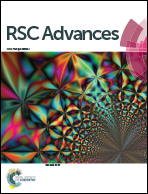Imine bond cross-linked poly(ethylene glycol)-block-poly(aspartamide) complex micelle as a carrier to deliver anticancer drugs
Abstract
The aim of this study is to develop degradable core-cross-linked polymeric micelles based on two water soluble methoxy-poly(ethylene glycol)-block-poly(aspartamide) (mPEG-PA) copolymers using the pH-sensitive imine bond. The ring opening polymerization of N-carboxyanhydride (NCA) was utilized to prepare the diblock copolymer methoxy-poly(ethylene glycol)-block-poly(benzyl L-aspartate). Amino and aldehyde modified mPEG-PAs were obtained by aminolysis and oxidation. The mixture of these two mPEG-PA polymer precursors was shown to form reversible core-cross-linked micelles by the formation of an imine linkage without the addition of cross-linker or catalyst. The structure of the prepared polymers was studied using NMR and FT-IR spectroscopy. The pH-sensitivity of the micelles was characterized by DLS. The mPEG-PA cross-linked micelle exhibited good biocompatibility according to the MTT assay against NIH/3T3 cells. The hydrophobic anticancer drug doxorubicin (DOX) was selected as a model drug and loaded into the micelles where it could be quickly released at low pH and was relatively stable under physiological conditions. Thereby, such an excellent nanocarrier provides a favorable platform to construct smart drug delivery systems for cancer therapy.


 Please wait while we load your content...
Please wait while we load your content...